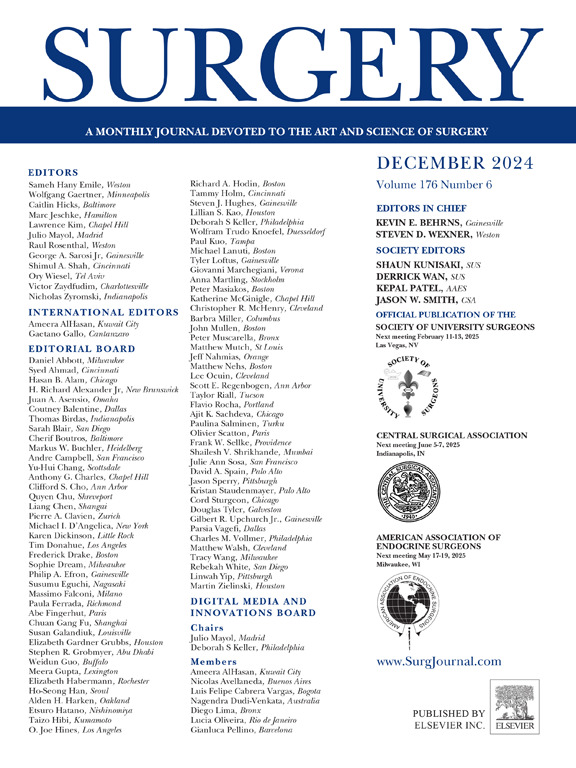Beyond Glasgow Coma Scale: Prehospital prediction of traumatic brain injury
IF 2.7
2区 医学
Q1 SURGERY
引用次数: 0
Abstract
Introduction
Early identification of traumatic brain injury followed by timely, targeted treatment is essential. We aimed to establish the ability of prehospital Glasgow Coma Scale score alone and combined with vital signs to predict hospital-diagnosed traumatic brain injury.
Methods
This study included adults from the 2017–2020 Trauma Quality Improvement Program data set with blunt mechanism. We calculated test characteristics of prehospital Glasgow Coma Scale score ≤12 alone and Glasgow Coma Scale score combined with heart rate and systolic blood pressure for predicting (1) any traumatic brain injury and (2) moderate to severe traumatic brain injury. Diagnostic performances were calculated in all patients and older adults (≥55 years). We used decision curve analysis to determine the net diagnostic benefit of prehospital Glasgow Coma Scale score combined with heart rate + systolic blood pressure over Glasgow Coma Scale score alone.
Results
Of 1,687,336 patients, 39.1% had any traumatic brain injury, 3.7% had moderate to severe traumatic brain injury, and 9.1% had a prehospital Glasgow Coma Scale score ≤12. Prehospital Glasgow Coma Scale score ≤12 alone had a sensitivity 83.1%, specificity 93.7%, negative predictive value 99.3%, and positive predictive value 33.7% for predicting moderate to severe traumatic brain injury. Adding prehospital heart rate <65/min and systolic blood pressure >150 mm Hg to Glasgow Coma Scale score ≤12 improved the positive predictive value for moderate to severe traumatic brain injury (55.3%), with a preserved negative predictive value of 96.4%. Decision curve analysis showed the traumatic brain injury prediction model including prehospital heart rate and systolic blood pressure had the greatest net benefit across most threshold probabilities.
Conclusion
Less than a third of adult blunt trauma patients with a prehospital Glasgow Coma Scale score ≤12 have moderate to severe traumatic brain injury. Supplementing Glasgow Coma Scale score with prehospital vital signs improves diagnostic accuracy, potentially by filtering out patients with altered consciousness due to shock. Future work should better identify patients for traumatic brain injury–specific treatments in prehospital settings, including triage destination.
超越格拉斯哥昏迷量表:院前预测创伤性脑损伤。
介绍:早期识别创伤性脑损伤并进行及时、有针对性的治疗至关重要。我们旨在确定院前格拉斯哥昏迷量表单独评分和结合生命体征预测医院诊断的创伤性脑损伤的能力:本研究纳入了 2017-2020 年创伤质量改进计划数据集中的钝性机制成人。我们计算了院前格拉斯哥昏迷量表单独评分≤12分和格拉斯哥昏迷量表评分与心率和收缩压相结合预测(1)任何创伤性脑损伤和(2)中重度创伤性脑损伤的测试特征。我们计算了所有患者和老年人(≥55 岁)的诊断性能。我们使用决策曲线分析法来确定院前格拉斯哥昏迷量表评分与心率+收缩压相结合比单独使用格拉斯哥昏迷量表评分在诊断方面的净效益:在1,687,336名患者中,39.1%的患者有任何脑外伤,3.7%的患者有中度至重度脑外伤,9.1%的患者院前格拉斯哥昏迷量表评分≤12分。仅凭院前格拉斯哥昏迷量表评分≤12分预测中重度脑外伤的灵敏度为83.1%,特异度为93.7%,阴性预测值为99.3%,阳性预测值为33.7%。在格拉斯哥昏迷量表评分≤12分的基础上增加院前心率150毫米汞柱,可提高中度至重度脑外伤的阳性预测值(55.3%),阴性预测值保留为96.4%。决策曲线分析表明,包括院前心率和收缩压在内的创伤性脑损伤预测模型在大多数阈值概率中具有最大的净效益:结论:在院前格拉斯哥昏迷量表评分≤12分的成年钝性创伤患者中,只有不到三分之一的患者患有中度至重度创伤性脑损伤。用院前生命体征补充格拉斯哥昏迷量表评分可提高诊断的准确性,可能会过滤掉因休克导致意识改变的患者。未来的工作应更好地识别院前环境中需要接受脑外伤特定治疗的患者,包括分流目的地。
本文章由计算机程序翻译,如有差异,请以英文原文为准。
求助全文
约1分钟内获得全文
求助全文
来源期刊

Surgery
医学-外科
CiteScore
5.40
自引率
5.30%
发文量
687
审稿时长
64 days
期刊介绍:
For 66 years, Surgery has published practical, authoritative information about procedures, clinical advances, and major trends shaping general surgery. Each issue features original scientific contributions and clinical reports. Peer-reviewed articles cover topics in oncology, trauma, gastrointestinal, vascular, and transplantation surgery. The journal also publishes papers from the meetings of its sponsoring societies, the Society of University Surgeons, the Central Surgical Association, and the American Association of Endocrine Surgeons.
 求助内容:
求助内容: 应助结果提醒方式:
应助结果提醒方式:


